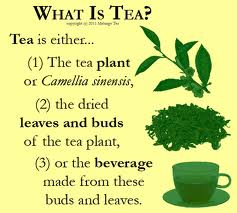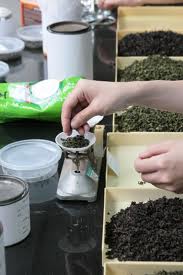What is Tea?
Tea is one of the most highly consumed drinks in the world, running second to water as the most consumed beverage. It is a delicious and aromatic beverage that is brewed and served as either a hot drink or as an iced drink. It is brewed by adding specially prepared tea leaves to hot water and, while flavors vary by class and variety of tea, a typical Green Tea can be described as having an earthy, astringent taste and it is enjoyed by many people. Tea can be drunk without anything added to it, although some people like a bit of honey (or some type of sweetener) or milk with their tea.
Tea is a term used to describe the drink as well as the generic description of the leafy plant it comes from. The all-important tea leaf comes from the Camellia Sinensisplant, an evergreen that grows primarily in sub-tropical and tropical climates. While today it’s grown in many locations, it has its roots (pun intended) deep in Chinese culture going back thousands of years. It was the drink of Emperors and kept from the common people for a very long time, but today it is consumed greedily around the world.

six classes of tea
Even if you are new to drinking tea, you’ve probably heard about Green or Black Tea, and perhaps even think that the reason they are called green or black is solely due to their color. That is true to the extent that early naming of tea classes were done by color. In fact, the class of tea known today as Pu-erh was once called Black Tea and Black Tea was referred to as “red” tea because the color name was already taken by Pu-erh. And, while it’s true that Green Tea is generally green and Black Tea is generally dark brown to black, the differences between them is not so much in their color but in the way they are manufactured into tea.
You might be surprised to learn that tea manufacturing can result in tea that falls into one of several distinct classes of tea – Green Tea and Black Tea being two of them. Yes, there are more classes of tea than just the well-known and popular Green and Black Teas. There are actually 6 different classes of tea – and each class of tea begins its journey into production as leaves on the Camellia Sinensis plant. But that’s where there similarities end. Once the tea leaves are plucked and sent to the tea masters to be processed into tea, the end result can vary greatly.
Tea processing variations can be directly related to a couple of factors:
Which leaves or buds are picked from the plant – i.e., buds only, top two leaves, etc., and
- How much oxidation is allowed to occur in the tea leaves before they are finish-fired and ready for market.
Of course, where and how the tea is grown also impacts the tea. Things like soil, climate, and humidity, cause further variations in tea taste. For example, Green Tea grown and produced in China will not taste the same as Green Tea grown and produced in Japan. But here we’ll focus on the distinct classes of tea.
The 6 Classes of Tea

6 Classes of Tea
So, what are the six classes of tea? Let’s take a look at them and how they come to be distinctive, standing alone, strong and delicious, each in their own right.
Traditionally, tea is classified based on methods with which it is processed and produced. The six classes of tea follow – to learn more about each class of tea, click on its description.
Again, you might think that it sure looks like tea is mainly described and distinguished by its color, and I don’t blame you for thinking that way. There certainly is a relationship; it’s just not the defining one for tea classification purposes.
The Distinction in Processing Tea
The first steps in tea processing are very similar from one class of tea to another and include:
- Plucking Tea Leaves
- Sorting/Cleaning
- Primary drying or withering
After these steps are complete, the tea master must make a decision based on the class of tea he wants to make, and that is: to oxidize, how much to oxidize, or not to oxidize at all. From here processing varies greatly from one class of tea to another.
While there is much to be said on many levels about each class of tea, from best production regions, to ceremonial uses, to health benefits and beyond, the most basic distinction between the classes is how long the tea leaves for any tea are allowed to remain in the oxidation phase of processing.
Oxidation in its simplest description, as it relates to tea, is when tea leaves are exposed to oxygen (typically just by setting the leaves out in the open air), which in turn breaks down certain compounds, such as enzymes, that once released interact with other chemicals to give tea its particular profile of distinct flavors, aromas, and other characteristics of a certain class of tea.
A brief description of oxidation levels for the tea classes follow. For more detailed information about a specific class of tea, click on the class name:
- White Tea – undergoes varying oxidation levels of 8 to 15%. Traditionally, only young buds from a specific ancient tea plant are used to make this class of tea – New Wave White Tea producers vary in this. It’s a delicate tea with hints of honey and chestnut flavors and aromas. White Tea is given its name because the tea buds have a white, silk-like feathering on them.
- Green Tea – undergoes zero oxidation. This tea is the leaf in its most natural state; without oxidation the leaf retains its natural color. Tea buds or young leaves are typically used to make this class of tea. Flavors tend to be astringent, grassy, earthy, or herbaceous.
- Yellow Tea – undergoes zero oxidation. This is rare tea that comes from the fat springs buds on the plant. It’s distinguished from Green Tea by an extra step in its processing that allows the leaves to yellow and produce its own distinct flavors that are less astringent, lighter, and lusher than Green Tea.
- Oolong Tea – a semi-oxidized tea. Oxidation levels vary greatly in a range of 10 to over 80 percent. Large, mature leaves of specific tea plants are used to make this special tea that requires the most complex of processing steps. Flavors are complex and generally sweet, floral, and fruity with little astringency.
- Black Tea – fully-oxidized (100%) tea. Leaves used vary from a fine pluck to a coarse pluck. Flavors tend to be hearty, bold, earthy, and full-bodied.
- Pu-erh Tea – varying oxidation levels. This tea is allowed to ferment, or age; a process that can go on for several months through many years. Pu-erh’s flavor ranges from exotic, earthy, woody, nutty, sweet, and musty, to herbaceous. A significant distinction of Pu-erh is that it improves over time.
Where’s the Herbal Tea Class?
About now you may be wondering why “Herbal Tea” is not listed here and the reason is simple. It’s not actually “tea”. Herbal tea is usually made with infusions of fruit, spices, or herbs, but without a tea leaf in sight. Since the etymology of the word “tea” comes from the Camellia Sinensis (tea plant), we refer to tea, the beverage, as a drink made from tea leaves or tea buds, or a combination of them. Tea is not a drink made from roots, flowers, stems, fruits, spices, or seeds of other plants. Beverages made from those ingredients are correctly identified as fruit infusions, tisanes, or herbal teas.